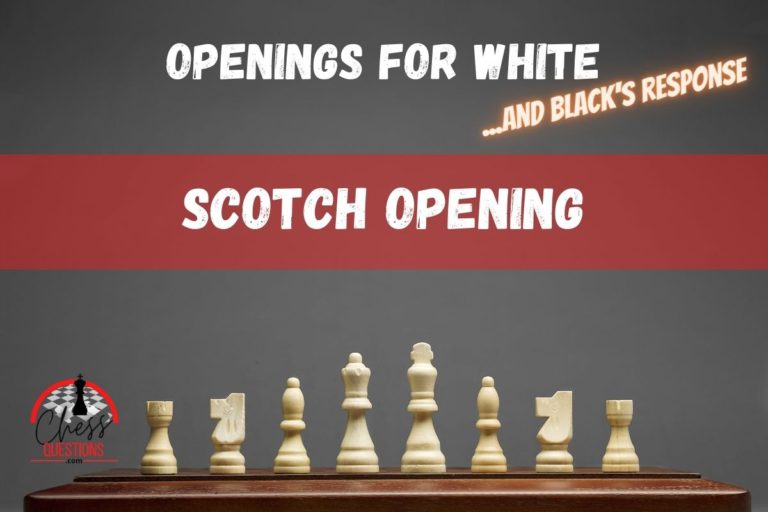The Best First Moves In Chess: For White or Black Pieces
⭐⭐⭐ Take 10 minutes to read and improve your chess game ➡️ : This article was first published on, and is Copyright of Chessquestions.com
The best first moves in chess for white and definite best responses from black are outlined in this article. And they all trigger opening names in theory
The first few moves of a chess game is an important choice because it signifies potential opening strategies for either side. This means there are arguably first moves to avoid as they are considered bad, or at least disadvantageous.
This article will provide the best 5 first moves that can be made in chess by the white pieces and the 5 moves black should make in response in most cases.
The Best First Moves In Chess
Making the first few moves in chess is a choice of 20 for white but a more limited choice for black as there are ‘best responses’ to whatever white has chosen.
These chess openings should be memorized by beginner chess players and the actual openings be the first to be studied in more depth as players look for control over the center squares in the opening.
The best first moves for white based on chess masters popularity are a choice of pawn to e4, d4, c4 or g3 or a Knight for f3, while the first move for black is dictated by white’s choice and is more often than not, a black pawn to e6 or c5
White First Moves and Black Responses
Alongside the first move for white here are the most common response for black for each
- White 1. e4 King’s Pawn Opening – Black 1…e6 French Defense
- White 1. d4 Queen’s Pawn Opening – Black 1…e6 Horwitz Opening
- White 1. Nf3 Reti Opening – Black 1…e6 Queen’s Gambit Invitation
- White 1. c4 English Opening – Black 1…c5 Symmetrical Variation
- White 1. g3 King’s Fianchetto Opening – Black 1…e5
There are a lot of different options to choose from, 20 possible first moves that can be made, and making the wrong decision can potentially place you in immediate trouble against a more experienced player.
I’ve put together a list of the 5 best first moves for white pieces, based on centuries of theory and modern chess engine analysis of popular openings. These moves will give you the best possible first move start to any game.
There is a lot more to do than make the first pawn move in chess though, so take note of the name of the openings for each of these first moves and work your way through studying each of them and if you have time take a look at basic chess strategy for the importance of pawn structure.
In the Lichess database, these are the most popular first moves made across millions of games featuring titled masters.
What first move is used most often in chess?
e4 is by far the most frequently used first move accounting for 45.16% of all games in the Lichess games database. d4 follows closely behind as the most used first move with 36%, e4 and d4 account for over 80% of all first moves. Nf3, c4 and g3 make up the rest of the top 5 first moves, the latter at under 1% highlighting the preference for e4 and d4
| First Move | No of Games | % of Total Games |
|---|---|---|
| e4 | 1,093,761 | 45.16% |
| d4 | 872,114 | 36.01% |
| Nf3 | 246,115 | 10.16% |
| c4 | 167,542 | 6.92% |
| g3 | 18,969 | 0.78% |
Source: Lichess data
We can see clearly the e4 opening as well as the d pawn make up over 80% of all first moves. You’ll never question which is the best first move in chess again. The evidence is clear.
The Most Popular First Move for Grandmasters
We would all love to be as good as to gain a grandmaster’s title in chess, but for almost all of us that is going to be out of reach, but is there any benefit in looking at what grandmaster chess players choose as their most popular chess openings?
Let’s take a look at what the [subjective] top ten chess players play most often as the first move.
| Player | High Rating | Total Games | Dates | 1st Move | Times Played | % |
|---|---|---|---|---|---|---|
| Magnus Carlsen | 2882 | 2014 | 1999-2022 | e4 | 924 | 45.88% |
| Garry Kasparov | 2851 | 1365 | 1973-2021 | d4 | 595 | 43.59% |
| Fabiano Caruana | 2844 | 1218 | 1999-2022 | e4 | 799 | 65.60% |
| Levon Aronian | 2830 | 1738 | 1993-2021 | d4 | 817 | 47.01% |
| Wesley So | 2822 | 1055 | 2003-2021 | e4 | 461 | 43.70% |
| Shakriyat Mamedtarov | 2820 | 1465 | 1999-2022 | d4 | 1198 | 81.77% |
| Maxime Lagrave | 2819 | 1571 | 1998-2021 | e4 | 1167 | 74.28% |
| Viswanathan Anand | 2817 | 1973 | 1984-2021 | e4 | 1648 | 85.53% |
| Vladamir Kramnik | 2817 | 1593 | 1984-2021 | d4 | 636 | 39.92% |
| Vaselin Topalov | 2816 | 1187 | 1986-2021 | e4 | 561 | 47.26% |
| Bobby Fischer | 2881 | 672 | 1954-1992 | e4 | 624 | 92.86% |
Data sourced from the wonderful database at chessgames.com
The table above is fascinating, I really enjoyed researching the data and making it, and there are some really interesting lines of info there.
7 of the 11 players featured open most often with e4, and all the other four players, Garry Kasparov, Levon Aronian, Mamedyarov and Kramnik play d4.
On average, the 7 players using e4 most frequently in their chess games, start with the move 65.05% of the time, with 4 of the 7 using it more than 65% of the time. In contrast, the d4 players have an average of 53%, which is slightly inflated by Shakiryat Mamedtarov, who is a hge d4 advocate playing it in 81.77% of games.
No other first move features, and trust me that extends much further down the list.
The total dominance of Bobby Fischer games beginning e4 is a stand-out statistic, a huge 93% of his games began this way when playing white. We can see Vishi Anand also as a very high percentage of his games starting this way.
This is not to say they play the same chess opening beyond the first move every time, without doubt as more moves are made, other openings will be utilized based on the preparation and strategy for the specific player they are facing, perhaps considering previous results and matches with them.
Bobby Fischer First Move

Chess legend and former world champion Bobby Fischer was a huge advocate of the Kings pawn opening 1. e4 and played it most often as can be seen by the figures above from the database where he utilized it nearly 93% of the times in his recorded games. He rarely went elsewhere, regardless of opponent.
In 672 games between 1954-1992 Bobby Fischer played 1. e4 an incredible 624 times, and even more incredibly, winning 61.9% of those games.
Compare that to over 1 million masters games in the Lichess database with a 33% win rate for white after 1. e4 and you can appreciate just what a phenomenon Fischer was during his time.
The Best First Moves In Chess for White
This is a list of the best 5 first moves for white in chess. They are written in notation, and the opening name is given with a brief description of each. You can research more of what has to follow in the opening in the dedicated articles on site.
- White 1. e4 King’s Pawn Opening
- White 1. d4 Queen’s Pawn Opening
- White 1. Nf3 Reti Opening
- White 1. c4 English Opening
- White 1. g3 King’s Fianchetto Opening
King’s Pawn Opening
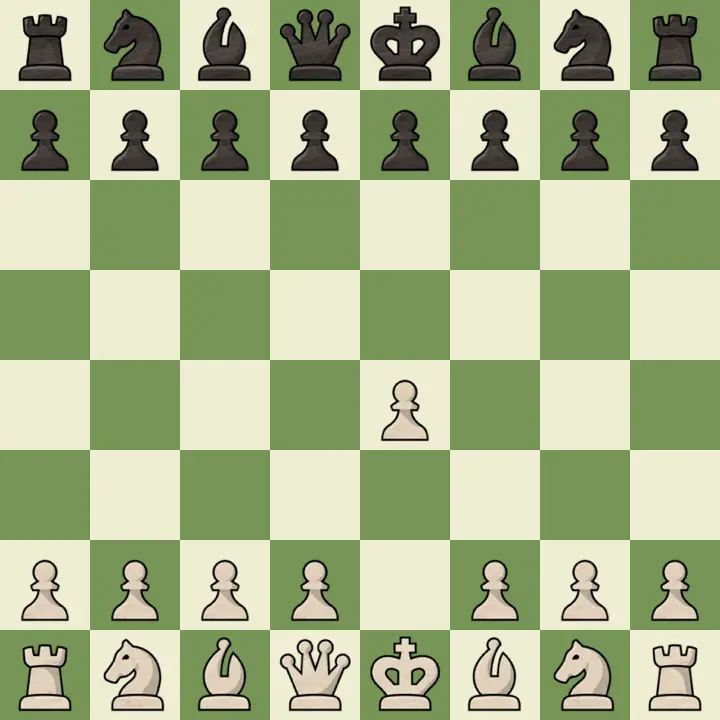
Openings with 1. e4 are traditionally considered more sharp and attacking than those with 1. d4, but this is an extreme generalization and both players will have many more opportunities to influence the type of position that appears.
e4 openings are generally more attacking and sharper than those with 1.d4, although it has to be said, for a single move there is much more than will happen within a few more moves and the position can develop in many different way from here.
The point of the e4 start is that is paves the way for a classic center for white with d4 on move 2
Queen’s Pawn Opening

Learning the basic Queen’s Gambit positions like the Queen’s Indian King’s Indian and the Nimzo will be obviously beneficial to using the d4 first move.
Whilst I often advocate not getting too caught up in opening theory as a beginner, learning the basic lines of these openings for white, will provide a good basis for the strategy and they are not as difficult as other openings that catch the eye.
Another advantage of d4, as opposed to e4, is there are fewer traps to be caught out with. You’ll not be falling foul of the Philidor defense for instance. It does remain though, that d4 has and will almost always play second fiddle to e4 as the first move for white at any level.
Reti Opening
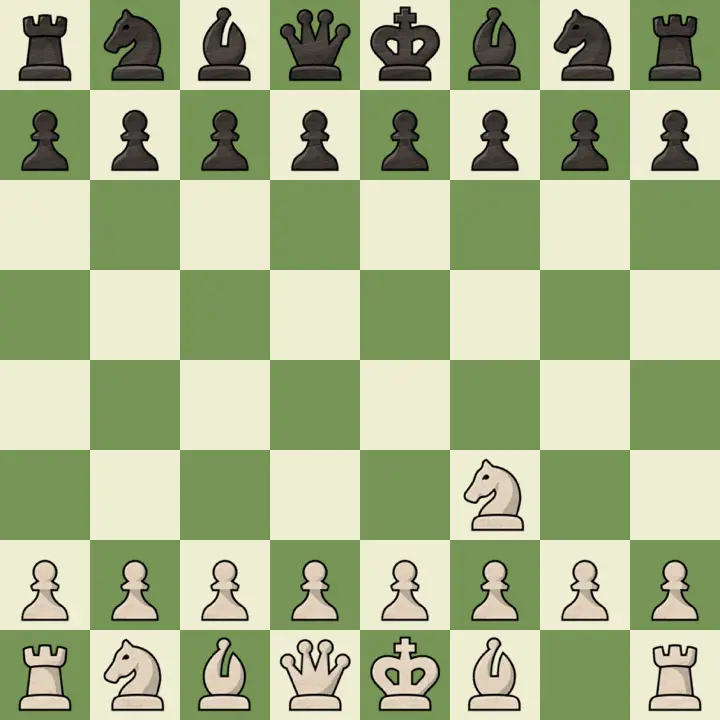
Reti’s Opening named after Richard Réti is often called The Zukertort Opening, or the Reti-Zukertort. Anyway, that is by the by and we are more concerned about what the actual first move is, and it is of course one that is not a pawn first move but one for the Kingside Night to the f3 square.
Nf3 is a bit of a fact-finding mission in that white wants to see the intention of Black and invites any response to then decide which way to play based on preference. Perhaps a bit in-depth thinking wise for beginners, but as you progress, you’ll pick up the sentiment of the invitation to black to play a hand.
English Opening
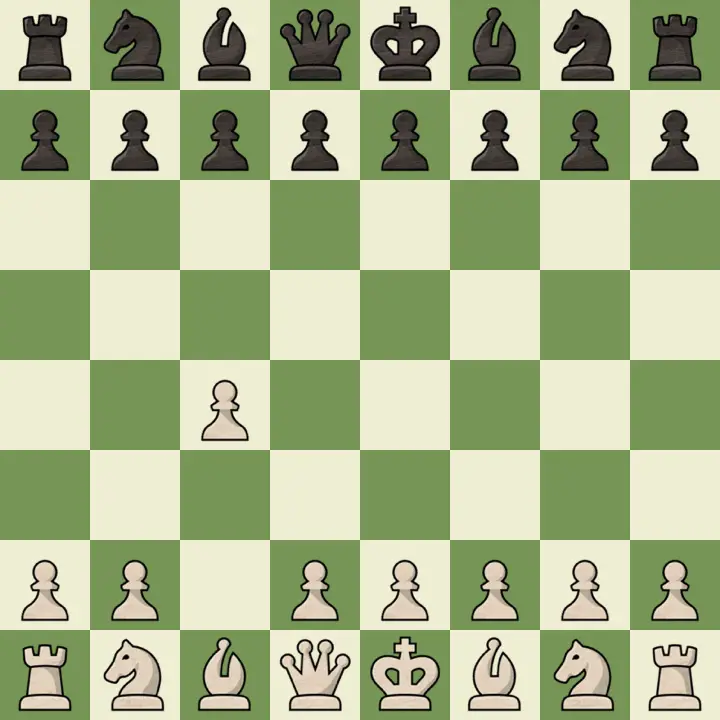
A hugely popular opening and a flank opening option over the more traditional center pawn openings, The English is often used at club level with a view to taking an opponent by surprise.
An unprepared player with the black pieces who doesn’t know the English lines can be caught out and quickly find themselves in trouble.
Take a look at the Complete English opening guide for more information on what to expect and how to counter it.
King’s Fianchetto Opening (Benko Opening)
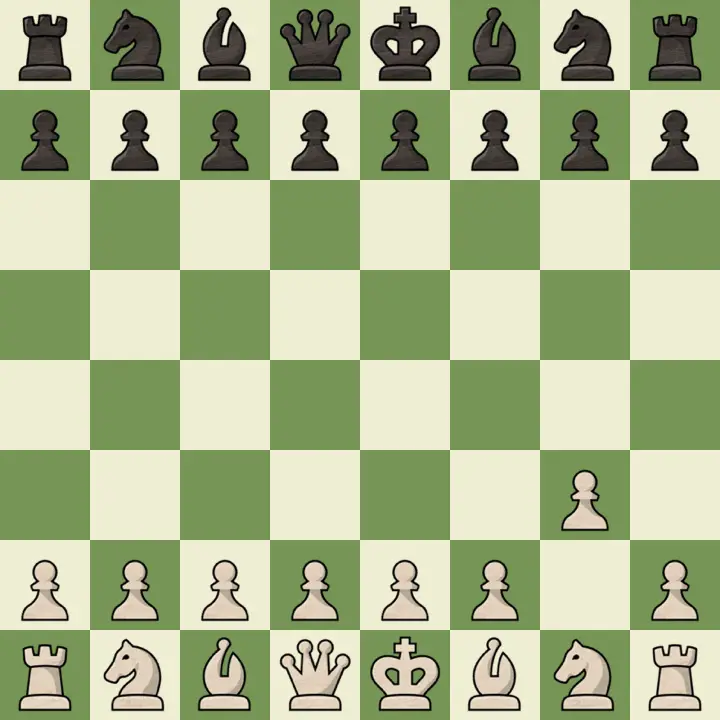
The clue is in the name here if you know what Fianchetto is of course. The idea is white is going to move the kingside Bishop to g2 and develop the knight for an early castle and heavy coverage of the kingside.
It provides a solid base from which to attack, but white has to be aware of the Benko gambit and understand the best strategy for facing it.
The Best First Moves In Chess for Black
At the very top of the chess grandmaster level, there is the general acceptance that very many games are drawn now with no distinct winners coming from many matches.
In the 2021 World Chess Championship between Magnus Carlsen and Ian Nepomniachtchi the first 5 games were drawn before Carlsen won the sixth. A further two games were drawn of the 11 played in total.
The point being, in the modern age of chess at the very top, it is reasonable to expect the black pieces to be playing for a draw given the first move advantage that white has (See below) and whilst at our level things are somewhat more open, your first response to Whites first move can be very important.
These first moves for black in response to the chess openings for white as detailed above may not those that we might expect most often but in terms of maintaining the balance as far as engine scores are concerned, coupled with ease of opening, may be the ones you want to concentrate on as you learn the craft.
- 1…e6 in response to 1. e4 is the French Defense
- 1…c5 in response to 1. e4 is the Sicilian defense
- 1…e6 in response to 1. d4 is the Horwitz Defense
- 1…Nf6 in response to 1. d4 is the Indian Game
- 1…c5 in response to 1…Nf3 in the Sicilian Invitation
- 1…c5 in response to 1. c4 is the symmetrical Variation of the English Opening
- 1…d5 is the only response you should play in response to the 1. g5 King’s Fianchetto opening, whereby white will play 2. Nf3 for the King’s Indian attack
Which First Move Should be Avoided for Black?
One thing which is often seen by beginners playing black is an attempt to create symmetry with 1…e5 This should be avoided as black will now be chasing center control. As Howard Staunton famously said…..
After black’s reply to 1.e4 with 1..e5, leaves him always trying to get into the game
Howard Staunton
So let’s look into more detail what the best opening moves for black in response to white’s choice are….
French Defense
The French Defense is an aggressive opening for black and a great choice in response for e4 for new chess players. It contains little in the way of theory but is rather more logical and simple in contrast but with a mind to ensuring the dark square bishop is utilized and protected in equal measure.
Usually, Black’s main idea is to create play on the queen’s side, while White focuses more on the kingside. Computer analysis generally supports the French defense. It gives Black a sound position.

Sicilian Defense
Statistically defending against e4 with the Sicilian defense is a solid strategy and offers a great opportunity but it also comes with a lot of deep variations and lines and anti-sicilian tactics. It is popular because of it’s flexibilities, but if you want to learn it, you need to concentrate on it alone until mastered and not get confused by learning other openings at the same time.

Horwitz Defense
The Horwitz Defense is a chess opening defined by the moves: 1. d4 e6 and is so named after This response to White’s Queen’s Pawn Game, is named for the German chess master and writer Bernhard Horwitz. who is known to have played it four times against fellow German master Daniel Harrwitz between 1849 and 1852.

Indian Game
The Indian Game or King’s Indian defence is an interesting response by black to white’s Queen’s pawn opening. It develops but slightly back on the board ceding the center to white for attack at a later stage.

The beauty in this defense is that whilst black is building a very solid and impenetrable defense, they can keep an eye on any mistakes white may make rushing to occupy the center that is given up.
Black will have to work for it as you can see in the positions in the gif below, but one mistake from white and black is wonderfully positioned to take advantage if white’s guard is down.
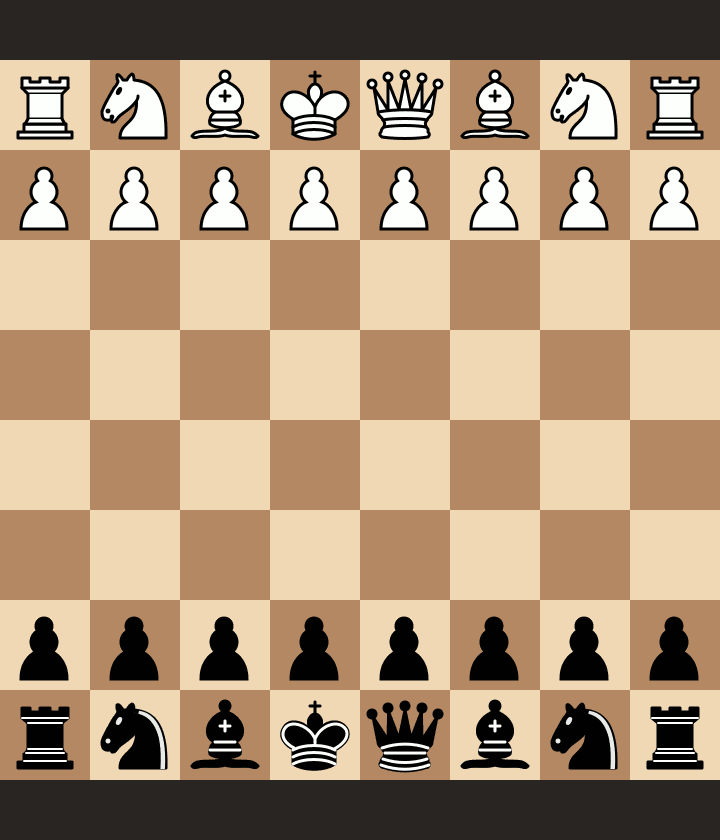
Reti Opening, Sicilian Invitation
The Reti opening is a very flexible opening for white, which is why it is so popular, defending against it can be a task, but employing the Sicilian invitation gives white something to think about.
Playing c5 instead of d5 releases the queen early, gives white something to think about, and when they follow up with e4, you have Nc6 for the old Sicilian variation or e6 for the franch variation.
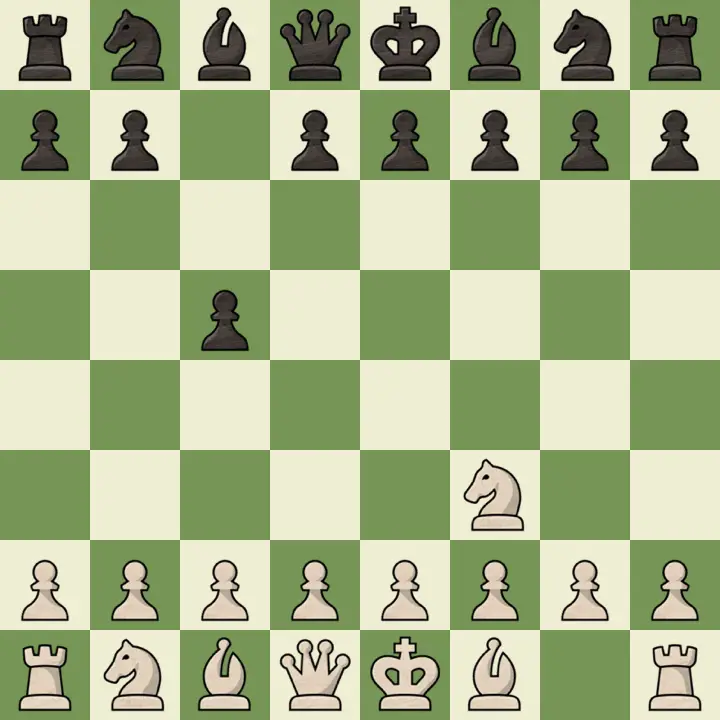
English Opening Symmetrical Variation
There are so many ways the English Opening can go, the symmetry can extend beyond the pawns, to two Knight or even all four knight, and it can go yet further.
Take a look at the English opening guide for other ways to counter 1. c4 first move.


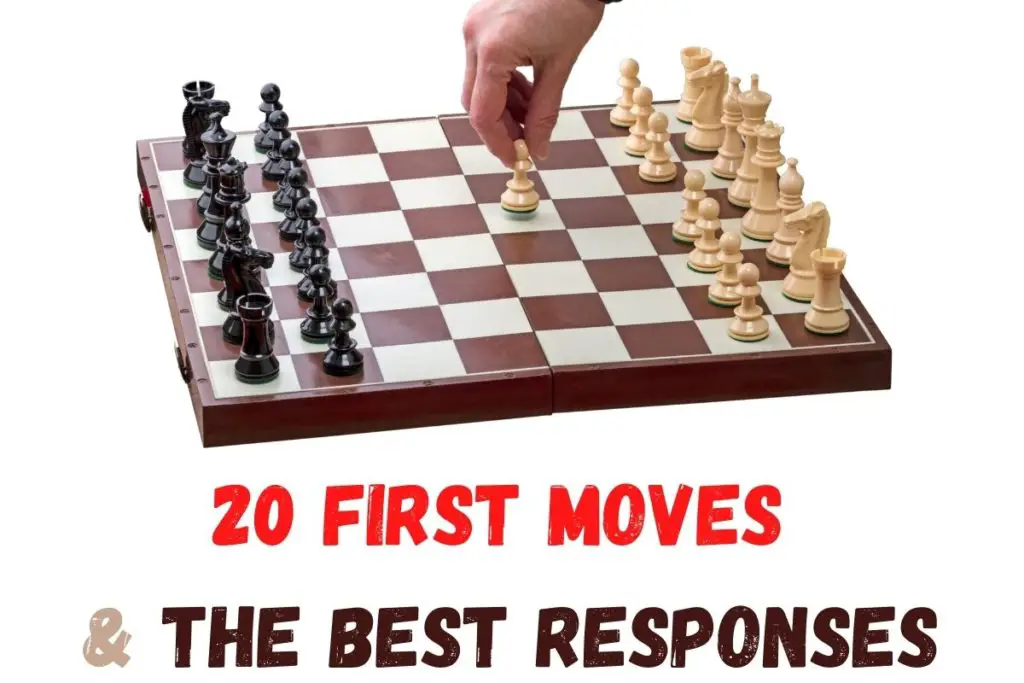
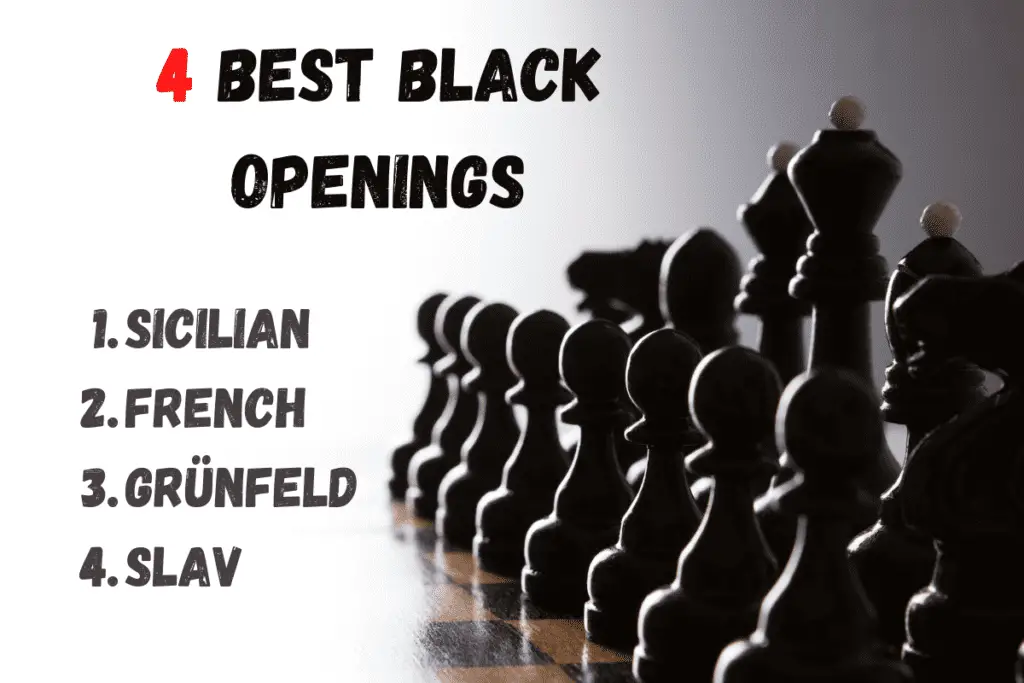
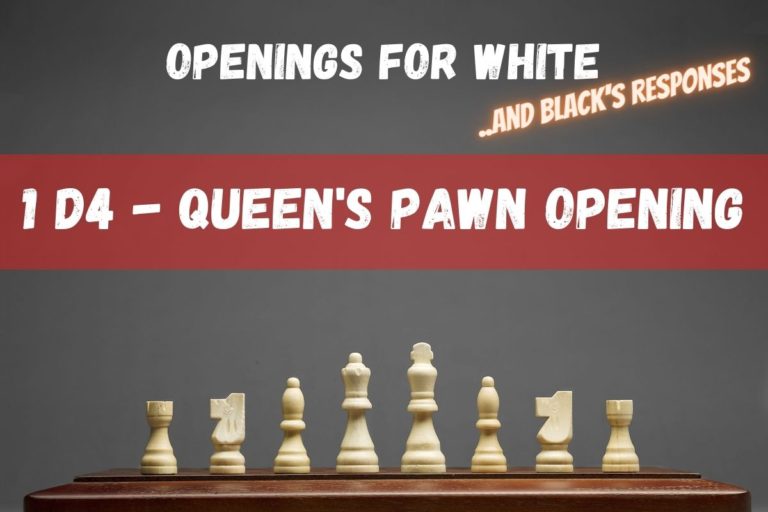



![When to Fianchetto in Chess [Strategy]](https://chessquestions.com/wp-content/uploads/2021/03/fianchetto-featured-image-768x512.png)
